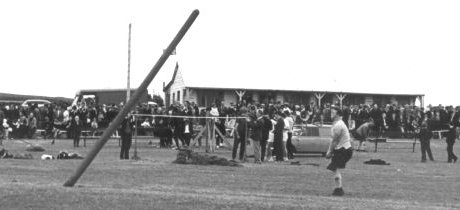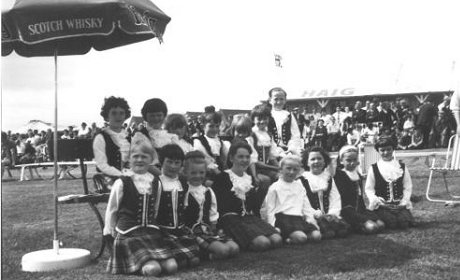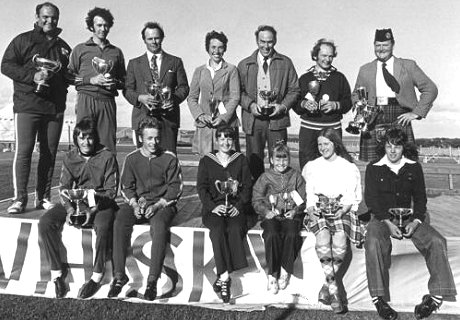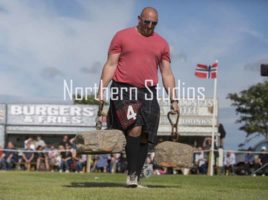History
The John O’Groat Journal, dated 22 September 1886, reported that the first Games started by the Halkirk Athletic Club was held in a field adjoining the new Gerston Distillery on Saturday 16th September. The Committee was 10 strong and the President and Secretary were Messrs H J MacKay and William Paterson respectively.16 events were staged as follows;21lb ball, 16lb hammer, running high leap, vaulting with pole, standing jump, running long jump, hop step & leap, 100 yards, quarter mile, one mile open and confined to Parish, 3 legged race, obstacle race, sack race, highland fling, tug o’ war (married versus single).
The next Games were held in a field near the Hoy railway station and they continued to be staged there until the outbreak of the First World War. The day was changed to a Monday so that it coincided with the Thurso shopkeepers’ holiday and the “townies” travelled to the Games by train.
In 1889 a road cycle race to Thurso and back, was introduced. This was to be a highlight of the Games over the years and it ran until 1968. The first winner in a time of 1 hour 6 minutes was H Davidson of Oldhall. Gordon MacDonald of Watten set the course record, of 33 minutes 21 seconds, in 1957. The race has recently been revived over a new course around Scotscalder and Westerdale.
James D Innes of Halkirk won the road race in 1897 and received a handsome silver cup. He won this cup three times and was entitled to keep it. His son David donated the cup to the Club in 1961 and it is presented to the cyclist gaining the most points in the open events.
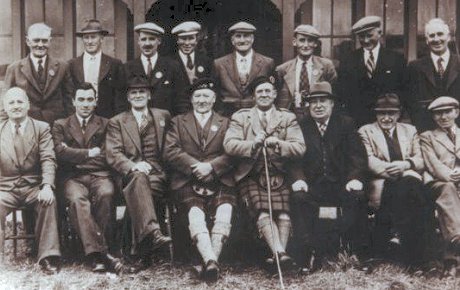 Halkirk Games Committee 1954:-
Halkirk Games Committee 1954:-
Back L to R – W.Sclater, H.Davidson, W.Munro, G.Polson, J.Sinclair, D.Sinclair, A.Davidson, C.Sutherland
Front L to R – T.Miller, I.Jack, J.Gunn, J.Budge, A.Swanson, A.Mackay, D.Manson, J.Paul.
The Games often attracted the landed gentry from Thurso Castle, Strathmore Lodge, the Glutt and Braal Castle. Regular visitors included Sir Tollemache Sinclair and many Lords and Ladies who were on holiday in the County for the hunting, fishing and shooting season.
In 1893 the prize money for the Heavies was 15 shillings for first, 10 for second and 5 for third. This was tremendous money for the time and attracted many of the champion athletes from South of the Ord.
A printed programme and clay pigeon shooting were introduced in 1894. Athletes from the South swept all before them and left the locals a bit shell-shocked. The shooting was stopped after a few years and was permanently re-introduced in 1926. Halkirk is one of the very few Games that stage clay pigeon shooting.A continuous downpour of rain in 1905 resulted in only 40 spectators turning up. This is thought to be the worst attendance and hopefully never to be repeated!The 1913 Games was the last before the Great War and the Club was reported to be in severe financial difficulties and struggled to stage the event.They were revived in 1920 but only due to the generosity and efforts of the Halkirk Comrades of the Great War and the Halkirk Farm Servants Union. A combination of good weather and the first appearance of the Thurso Pipe Band, resulted in record takings of £61 and the event was up and running again.
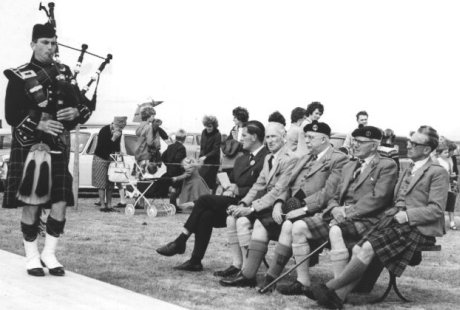 Piper with watching judges – 1960’s
Piper with watching judges – 1960’s
The venue changed to its present location, the Recreation Park, in 1921. Sir Archibald Sinclair gifted the Park to the community with great ceremony on Games day, Monday 29th August. Lady Sinclair was led to the Park by the Thurso Pipe Band and used a silver ceremonial key to unlock the gate. The gate stood underneath an archway made of heathers and flowers with the word “Welcome” invitingly displayed.
The Games were very popular with athletes and spectators throughout the 1920’s and 30’s and quickly regained its reputation for good organisation and prize money. Charlie Hercher the famous showman was reported to have entertained the crowd in the ring, in 1930. He continued to appear at Halkirk until the 1970’s. Charlie’s sons and now grandsons, have continued the family tradition of the “side-shows” and still regularly travel to Halkirk with their large fleet of lorries and caravans. The last Games before the Second World War were held just a few days before the outbreak in September 1939. In 1940 the Club donated £10 and 10 Shillings to the Spitfire fund.
The Games were revived in 1952 and it attracted a crowd of over 1,000 and a gate of £113. The newly elected President was Alexander Swanson of Gerston and the Secretary was James B Gunn of Gerston, a position he held since 1925. They led a Committee of 20 men and carried forward the high reputation of the Games and record crowds flocked through the gates, with over 3,000 attending in 1957. The appearance of caber tossing was first reported in 1957.
The decision to invite a top grade pipe band to act as the star attraction was made in 1967. The Committee has annually upheld this decision and the Games are renowned for the high quality of pipe bands that they are able to attract to the far North of Scotland. The bands love the friendly atmosphere and generous hospitality and often ask to be invited back!
The attendance peaked in the 1970’s with regular crowds 5,000 to 6,000 being reported. The excellent prize money attracted all of the top athletes and ensured that the crowds were entertained.The Club changed its name from the Halkirk Athletic Club to the Halkirk Highland Games Association in 1981. The new name was deemed more appropriate for the type of event being staged. The organisation of the Games proved increasingly popular and many locals were queuing up to be on the Committee. The size of the Committee was restricted to 36 in the mid 1980’s, any larger and meetings would be very difficult to control.The crowds diminished to around 2,000 from the mid 1980’s to the mid 1990’s. This was thought to be due to a combination of indifferent weather and the increase of other attractions such as video, satellite TV and computers.
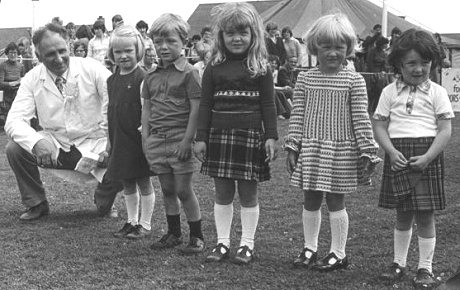 Children’s Races – 1979
Children’s Races – 1979
The honour of staging the Scottish Championship for throwing the 28lb weight for distance was first received in 1991. The event is still one of the star attractions. A revival in crowd numbers and the emergence of corporate sponsorship with hospitality tents, occurred in the late 1990’s. This has helped to ensure that the prize money remains one the best in Scotland and thus attracts the best athletes. Three World records for the Heavyweight events were broken at Halkirk by the World Champion, Matt Sandford of Australia, in 1998 and 1999.
Record gate monies were recorded in 1998 (£6,500), 1999 (£7,200) and 2000 (£9,500). This also ensures that the Committee can continue to offer one of the best purses in the Country, to invite the top pipe bands and to upgrade equipment/spectator facilities. The South African Cape Town Highlanders pipe band gave a very professional and colourful performance in the year 2000. They were the first pipe band from another Country to appear at Halkirk. Grampian Police pipe band also performed in 2000 and it was only the second time that two bands had performed together. The previous year was 1984.
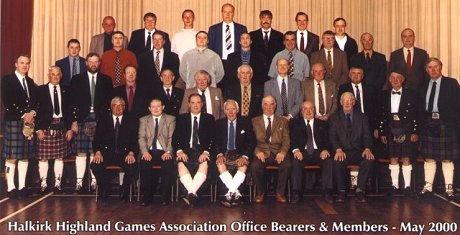 Halkirk Games Committee 2000:-
Halkirk Games Committee 2000:-
Back L to R – A.Bremner, D.Miller, S.Blackwood, A.Davidson, M.MacDonald, D.Mackay, E.Sinclair
2nd Back L to – R J.Miller, J.Budge, A.D.Budge, M.Budge, S.Gunn, M.Munro, C.Swanson, A.Gunn, L.Gunn
3rd Back L to R – J.B.Gunn (jnr), F.W.Spence, A.Swanson, J.J.Miller, G.MacDonald, W.D.Budge, A.S.Budge, C.Gordon, D.Davidson, G.Manson, R.MacDonald, A.C.Gunn.
Front L to R – W.Manson, J.W.Banks, J.P.Campbell, P.Murchison, J.B.Gunn (Snr), C.H.Miller, P.J.W.Blackwood.
The 100th Games were held in 2003 and the committee pulled out all the stops to make it a very special one. A unique heavyweight contest, ‘The Atlantic Challenge’, was staged with teams representing Scotland, the USA and the rest of the world. The Scottish team of brothers Alistair and Murray Gunn & Bruce Aitken, just pipped the USA team of Harrison Bailey III, James Parman & David Barron. The rest of the world team had Matt Sandford of Australia winning 6 of the 9 events, but his team mates Ian MacKay, Thurso and James McBeath, Dunbeath, could not match the speed, power and technique of the others and the team came third.
The national press and TV crews recorded the days events, including a special car pull event. The heavies had to pull an MG Rover 75 over a length of 20m, using a rope by a hand over hand technique. Sandford won with a time of 20.2 secs.
Thurso and Strathclyde Police pipe bands entertained the large 4,000 crowd.
For the centenary, the committee published a book on the history of the Games, written by committee member James B Gunn, Jnr. With over 70 pages of interesting facts, figures and photos, the book was an instant best seller and is sold out.
The success of the heavyweight challenge match has resulted in similar challenges in the following years, with the world’s best ‘Heavies’ competing at Halkirk for one of the best prize purses on the world circuit. The Games has one of the largest total prize money on offer of any Games in Scotland (over £16,000 in 2018) and regularly attracts national and world champions in all of the disciplines. There is also great prizes for beating ground and national records, with £1,000 on offer for breaking a world record in the heavy events and a British record in the track and field jumping events.
With regular crowds of around 3,000, the Halkirk Games is one of the most popular sporting events in the Highlands. Many local, national & international companies have hospitality tents at the Games to entertain clients and it has been described as the North’s equivalent to Ascot or the Open!
Halkirk’s reputation on the international circuit was rewarded with the honour of hosting the 2016 World Invitational Heavy Events Championships. Ten of the best heavyweight athletes from six countries competed for the Webster trophy. Scott Rider from England won and beat the two USA stars and former world champions, Dan McKim and Matt Vincent, who came 2nd and 3rd.

